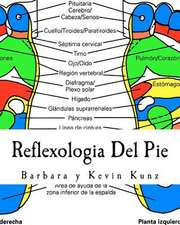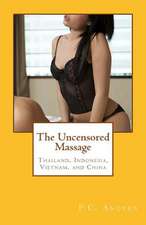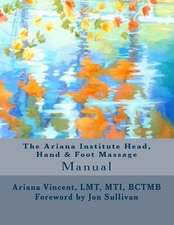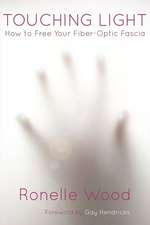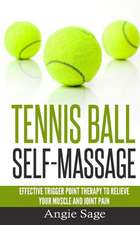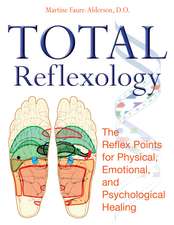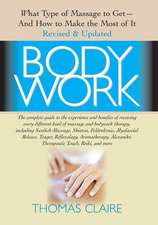Total Reflexology of the Hand: An Advanced Guide to the Integration of Craniosacral Therapy and Reflexology
Autor Martine Faure-Alderson D.O.en Limba Engleză Paperback – 7 sep 2016
One of the most defining physical characteristics of humanity, the hands contain reflex zones and pressure points related to the systems and organs of the body just like the feet. The reflex zones and points of the hands present the most effective means of treating psychological and neurological disorders due to their sophisticated relationship with the brain.
Applying her ground-breaking combination of reflexology and craniosacral therapy to the hands, Dr. Martine Faure-Alderson explains how to use hand reflexology to treat the brain and each of the body’s systems, from the digestive system to the human energetic system. She provides precise full-color mapped hand diagrams illustrating the exact placement of the points according to the bones of the hands, the result of more than 40 years of research and clinical practice. She explains how to use the occipital zones of craniosacral therapy to pinpoint which zones and points on the hands to treat.
Examining the psychological level of brain-hand interactions, the author reveals how neurological dysfunctions and mental disorders respond more readily to hand reflexology than to other forms of therapies. She explains how many physical ailments have a psychological component and how reflexology automatically triggers the release of endorphins by working directly on the autonomic nervous system.
Applying her ground-breaking combination of reflexology and craniosacral therapy to the hands, Dr. Martine Faure-Alderson explains how to use hand reflexology to treat the brain and each of the body’s systems, from the digestive system to the human energetic system. She provides precise full-color mapped hand diagrams illustrating the exact placement of the points according to the bones of the hands, the result of more than 40 years of research and clinical practice. She explains how to use the occipital zones of craniosacral therapy to pinpoint which zones and points on the hands to treat.
Examining the psychological level of brain-hand interactions, the author reveals how neurological dysfunctions and mental disorders respond more readily to hand reflexology than to other forms of therapies. She explains how many physical ailments have a psychological component and how reflexology automatically triggers the release of endorphins by working directly on the autonomic nervous system.
Preț: 104.25 lei
Nou
Puncte Express: 156
Preț estimativ în valută:
19.95€ • 20.61$ • 16.60£
19.95€ • 20.61$ • 16.60£
Carte disponibilă
Livrare economică 04-18 martie
Livrare express 18-22 februarie pentru 31.48 lei
Preluare comenzi: 021 569.72.76
Specificații
ISBN-13: 9781620555316
ISBN-10: 162055531X
Pagini: 144
Ilustrații: Full-color throughout
Dimensiuni: 216 x 279 x 10 mm
Greutate: 0.52 kg
Editura: Inner Traditions/Bear & Company
Colecția Healing Arts Press
ISBN-10: 162055531X
Pagini: 144
Ilustrații: Full-color throughout
Dimensiuni: 216 x 279 x 10 mm
Greutate: 0.52 kg
Editura: Inner Traditions/Bear & Company
Colecția Healing Arts Press
Notă biografică
Martine Faure-Alderson, D.O., has integrated osteopathy, naturopathy, acupuncture, homeopathy, and reflexology into her medical practice since the 1960s. A reflexology student of Doreen Bayly, she founded the Total Reflexology Therapy school in Paris in 1974. After more than 25 years of research, she developed Cranio-Sacral Reflexology (CSR), a unique combination of osteopathy, cranio-sacral therapy, and reflexology, and in 2010 founded the CSRI Academy of Excellence in London. She gives seminars throughout the world and is the author of Total Reflexology. She lives in England.
Extras
The Plexuses and Their Treatment
The plexuses are energetic nervous centers that establish contact between the three levels of the individual (mental, emotional, and physical) through the brain, endocrine glands, and the cells. The endocrine glands assimilate hormonal signals (the holistic mechanism of integration) and release hormones that are transported by the blood stream into the cells. Each endocrine center thereby plays a role in the body’s physiology and that of each plexus.
The plexuses, of which there are seven, form a kind of crossroads where there is an anastomosis of the nerves.
In the Physical Zone
1. Coccygeal Plexus
2. Hypogastric Plexus
In the Emotional Zone
3. Solar (or Digestive) Plexus
4. Cardiac Plexus
5. Thyroid Plexus
In the Mental Zone
6. Pituitary (or Hypophyseal) Plexus
7. Pineal (or Coronal) Plexus
1. The Coccygeal Plexus
This plexus near the pubis can be found on the hand on the lower inside portion of the pisiform bone. It is the seat of procreation, growth, and sexuality.
The testicles release endogens like testosterone.
The ovaries release estrogens. These substances are responsible for secondary sexual characteristics, and are involved in the function of the central nervous system and the libido.
Progesterone prepares the uterus for implantation.
The reflexology treatment of this plexus will help regulate growth, sexuality (especially in cases of sterility), and disrupted menstrual cycles.
2. Hypogastric Plexus
This plexus is located two fingers’ width beneath the navel and its reflex point can be found on the hand--palm side up--on the inner edge of the triquetral bone, beneath the coccygeal.
This is the seat of elimination and excretion. Bones, nails, and hair draw their energy from this plexus.
It is also the seat of creative inspiration.
Its corresponding glands are the adrenals.
The treatment of this point will be effective in relieving pain, and for dealing with elimination problems, and inflammation.
3. The Solar (or Digestive) Plexus
This plexus can be found above the navel, and its reflex point on the hand--palm side up--is located in the
inner edge of the third metacarpal.
It is the seat of fear and anxiety. It governs digestion and corresponds to the pancreas and liver.
It is the primary stabilizer of emotions and reactions.
Working on this plexus will be helpful in the treatment of diabetes and hypoglycemia, digestion, and the
metabolizing of fats and sugar.
4. The Cardiac Plexus
This plexus is located at the level of vertebra T4 and its reflex point can be found on the palm side of the hand, between the top of the second and third metacarpals.
It forms the connection between mind and body. It is the first to be affected by stress and mental attitudes.
This plexus is the protection center of the body and the immune system, it governs the circulation of lymph, growth, and muscle strength. It corresponds to the thymus.
Working on this plexus makes it possible to treat edemas, muscles, and circulation, while stimulating the body’s immune system defenses.
5. The Thyroid Plexus
This plexus is located in front of the trachea and its reflex point can be found at the base of the first phalanx
of the thumb, looking at the palm of the hand.
It is connected to oral expression.
It controls calcium and therefore has an effect on growth, spasmophilia, and osteoporosis.
Treatment of this plexus will therefore be effective on metabolic disorders, spasmophilia, osteoporosis, arthritis,
and osteoarthritis.
6. The Pituitary (or Hypophyseal) Plexus
This plexus is located in the center of the forehead and its reflex point is on the middle of the second phalanx of the thumb, on the palm side of the hand.
It controls body fluids such as blood and water.
It corresponds to the pituitary gland and the hypothalamus.
The purpose of treating this plexus is to restore balance to the entire hormonal system.
7. The Pineal or Coronal Plexus
This plexus is located in the center of the head and its reflex point is on the thumb (above those of the pituitary and hypothalamus).
The pineal and related points can also be found on the pads of the other fingers.
As the contact point between the endocrine system and the nervous system, the pineal gland distributes hormones to the hypothalamus and to the pituitary gland.
Working on this plexus helps treat both endocrine and nervous disorders.
The application of deep pressure to these reflex points restores balance to plexus function, thereby helping to regulate the hormonal, immune, lymphatic and craniosacral systems. This in turn helps restore homeostasis to the entire body.
Chakras and Plexuses
The chakras, or energy points of the body, are used to determine the state of the individual’s emotional and physical health. They can be damaged by a traumatic accident or emotional shock. The major chakras can be found in the middle of the palms of the hands and the soles of the feet.
Chakras and Plexuses
THE CHAKRAS
Sahasrara
Ajna
Vishuddha
Anahata
Manipura
Svadhisthana
Muladhara
THE PLEXUSES
Pineal
(Tentorium sacrum)
Pituitary
Thyroid
Cardiac
Solar
Hypogastric
Coccygeal
The plexuses are energetic nervous centers that establish contact between the three levels of the individual (mental, emotional, and physical) through the brain, endocrine glands, and the cells. The endocrine glands assimilate hormonal signals (the holistic mechanism of integration) and release hormones that are transported by the blood stream into the cells. Each endocrine center thereby plays a role in the body’s physiology and that of each plexus.
The plexuses, of which there are seven, form a kind of crossroads where there is an anastomosis of the nerves.
In the Physical Zone
1. Coccygeal Plexus
2. Hypogastric Plexus
In the Emotional Zone
3. Solar (or Digestive) Plexus
4. Cardiac Plexus
5. Thyroid Plexus
In the Mental Zone
6. Pituitary (or Hypophyseal) Plexus
7. Pineal (or Coronal) Plexus
1. The Coccygeal Plexus
This plexus near the pubis can be found on the hand on the lower inside portion of the pisiform bone. It is the seat of procreation, growth, and sexuality.
The testicles release endogens like testosterone.
The ovaries release estrogens. These substances are responsible for secondary sexual characteristics, and are involved in the function of the central nervous system and the libido.
Progesterone prepares the uterus for implantation.
The reflexology treatment of this plexus will help regulate growth, sexuality (especially in cases of sterility), and disrupted menstrual cycles.
2. Hypogastric Plexus
This plexus is located two fingers’ width beneath the navel and its reflex point can be found on the hand--palm side up--on the inner edge of the triquetral bone, beneath the coccygeal.
This is the seat of elimination and excretion. Bones, nails, and hair draw their energy from this plexus.
It is also the seat of creative inspiration.
Its corresponding glands are the adrenals.
The treatment of this point will be effective in relieving pain, and for dealing with elimination problems, and inflammation.
3. The Solar (or Digestive) Plexus
This plexus can be found above the navel, and its reflex point on the hand--palm side up--is located in the
inner edge of the third metacarpal.
It is the seat of fear and anxiety. It governs digestion and corresponds to the pancreas and liver.
It is the primary stabilizer of emotions and reactions.
Working on this plexus will be helpful in the treatment of diabetes and hypoglycemia, digestion, and the
metabolizing of fats and sugar.
4. The Cardiac Plexus
This plexus is located at the level of vertebra T4 and its reflex point can be found on the palm side of the hand, between the top of the second and third metacarpals.
It forms the connection between mind and body. It is the first to be affected by stress and mental attitudes.
This plexus is the protection center of the body and the immune system, it governs the circulation of lymph, growth, and muscle strength. It corresponds to the thymus.
Working on this plexus makes it possible to treat edemas, muscles, and circulation, while stimulating the body’s immune system defenses.
5. The Thyroid Plexus
This plexus is located in front of the trachea and its reflex point can be found at the base of the first phalanx
of the thumb, looking at the palm of the hand.
It is connected to oral expression.
It controls calcium and therefore has an effect on growth, spasmophilia, and osteoporosis.
Treatment of this plexus will therefore be effective on metabolic disorders, spasmophilia, osteoporosis, arthritis,
and osteoarthritis.
6. The Pituitary (or Hypophyseal) Plexus
This plexus is located in the center of the forehead and its reflex point is on the middle of the second phalanx of the thumb, on the palm side of the hand.
It controls body fluids such as blood and water.
It corresponds to the pituitary gland and the hypothalamus.
The purpose of treating this plexus is to restore balance to the entire hormonal system.
7. The Pineal or Coronal Plexus
This plexus is located in the center of the head and its reflex point is on the thumb (above those of the pituitary and hypothalamus).
The pineal and related points can also be found on the pads of the other fingers.
As the contact point between the endocrine system and the nervous system, the pineal gland distributes hormones to the hypothalamus and to the pituitary gland.
Working on this plexus helps treat both endocrine and nervous disorders.
The application of deep pressure to these reflex points restores balance to plexus function, thereby helping to regulate the hormonal, immune, lymphatic and craniosacral systems. This in turn helps restore homeostasis to the entire body.
Chakras and Plexuses
The chakras, or energy points of the body, are used to determine the state of the individual’s emotional and physical health. They can be damaged by a traumatic accident or emotional shock. The major chakras can be found in the middle of the palms of the hands and the soles of the feet.
Chakras and Plexuses
THE CHAKRAS
Sahasrara
Ajna
Vishuddha
Anahata
Manipura
Svadhisthana
Muladhara
THE PLEXUSES
Pineal
(Tentorium sacrum)
Pituitary
Thyroid
Cardiac
Solar
Hypogastric
Coccygeal
Cuprins
PART ONE
Introduction to Reflexology
History
General Principles of Reflexology
Distinctive Features of Total Reflexology Therapy
PART TWO
The Sensational Hand-Brain Tandem
The Hand, the Servant of the Brain
The Brain, the Hand’s “Motor”
The Cranial Concept
PART THREE
The Therapeutic Experience
The Basics of Reflexology
The Reflexology Treatment
PART FOUR
Hand Reflexology and the Systems and Energy Centers of the Body
The Craniosacral System
The Neuroendocrine System
The Main Organs and Organ Systems
The Plexuses
PART FIVE
Beyond Reflexology: The Essence of Being
Live, but Live Well--Creating a Healthy Lifestyle
Brain Structures and the Evolution of Consciousness
About the Author
Total Reflexology Training Seminars
Bibliography
List of Plates
Index
Introduction to Reflexology
History
General Principles of Reflexology
Distinctive Features of Total Reflexology Therapy
PART TWO
The Sensational Hand-Brain Tandem
The Hand, the Servant of the Brain
The Brain, the Hand’s “Motor”
The Cranial Concept
PART THREE
The Therapeutic Experience
The Basics of Reflexology
The Reflexology Treatment
PART FOUR
Hand Reflexology and the Systems and Energy Centers of the Body
The Craniosacral System
The Neuroendocrine System
The Main Organs and Organ Systems
The Plexuses
PART FIVE
Beyond Reflexology: The Essence of Being
Live, but Live Well--Creating a Healthy Lifestyle
Brain Structures and the Evolution of Consciousness
About the Author
Total Reflexology Training Seminars
Bibliography
List of Plates
Index
Recenzii
“An essential resource for anyone interested in balancing the brain and craniosacral systems through reflexology. The superbly detailed illustrations on craniosacral reflexology are a treasure trove of valuable information for healers. If you want to know how to affect the cranium, spine, and brain through working with the hand, then Total Reflexology of the Hand is an indispensable guidebook that will benefit both you and your clients.”
“Total Reflexology of the Hand is a ‘must-have’ for all reflexologists seeking to deepen their knowledge and take their practice to whole new levels. It is elegant and insightful in its holistic approach to integrating the brain-body with the cranial concept in hand reflexology. This book is a joy to read and learn from. I highly recommend it.”
“This is a complementary approach that we can use in our practice to help our patients. Thanks to Martine for always giving us a bigger picture of our practice and more tools to handle it as professionals and caregivers.”
“Total Reflexology of the Hand is a ‘must-have’ for all reflexologists seeking to deepen their knowledge and take their practice to whole new levels. It is elegant and insightful in its holistic approach to integrating the brain-body with the cranial concept in hand reflexology. This book is a joy to read and learn from. I highly recommend it.”
“This is a complementary approach that we can use in our practice to help our patients. Thanks to Martine for always giving us a bigger picture of our practice and more tools to handle it as professionals and caregivers.”
Descriere
How to apply the precise treatment techniques of Total Reflexology, which combines craniosacral therapy and foot reflexology, to the hands



